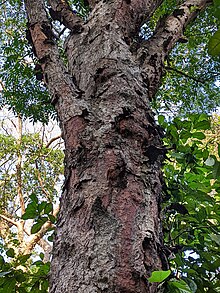| Ganophyllum falcatum | |
|---|---|

| |
| In the Andaman Islands | |
| Conservation status | |
 Least Concern (IUCN 3.1) | |
| Scientific classification | |
| Kingdom: | Plantae |
| Clade: | Tracheophytes |
| Clade: | Angiosperms |
| Clade: | Eudicots |
| Clade: | Rosids |
| Order: | Sapindales |
| Family: | Sapindaceae |
| Genus: | Ganophyllum |
| Species: | G. falcatum |
| Binomial name | |
| Ganophyllum falcatum Blume | |
Ganophyllum falcatum, commonly known as the scaly ash, is an evergreen rainforest tree. It grows up to 32 metres high and has rough, flaky bark. The species was described by German-Dutch botanist Carl Ludwig Blume in 1851 based on plant material collected from the coast of New Guinea.It is native to Africa, the Andaman Islands, Asia, Malesia and northern Australia. The ovoid fruits are consumed by fruit pigeons and cassowaries.
References
- ^ Botanic Gardens Conservation International (BGCI) & IUCN SSC Global Tree Specialist Group (2018). "Ganophyllum falcatum". IUCN Red List of Threatened Species. 2018: e.T136088720A136088722. Retrieved 1 January 2024.
- Reynolds, S. (1984). "Notes on Sapindaceae, III". Austrobaileya. 2 (1): 29–64. JSTOR 41739161.
- ^ "Ganophyllum falcatum". Flora of Australia. Australian Biological Resources Study, Department of Agriculture, Water and the Environment: Canberra. 2020. Retrieved 19 June 2021.
- ^ "Ganophyllum falcatum". Australian Plant Name Index (APNI). Centre for Plant Biodiversity Research, Australian Government. Retrieved 19 June 2021.
- ^ F.A.Zich; B.P.M.Hyland; T.Whiffen; R.A.Kerrigan (2020). "Ganophyllum falcatum". Australian Tropical Rainforest Plants Edition 8 (RFK8). Centre for Australian National Biodiversity Research (CANBR), Australian Government. Retrieved 19 June 2021.
External links
- "Ganophyllum falcatum Blume". Atlas of Living Australia.
This Sapindales-related article is a stub. You can help Misplaced Pages by expanding it. |
This Australian rosid article is a stub. You can help Misplaced Pages by expanding it. |